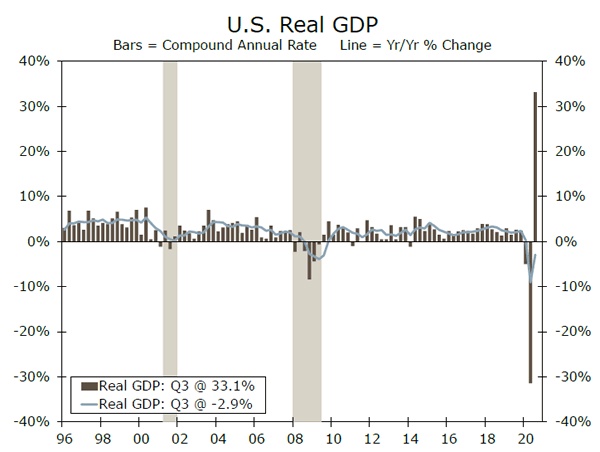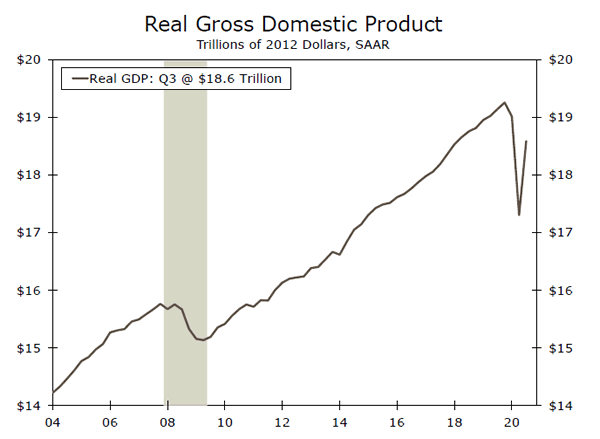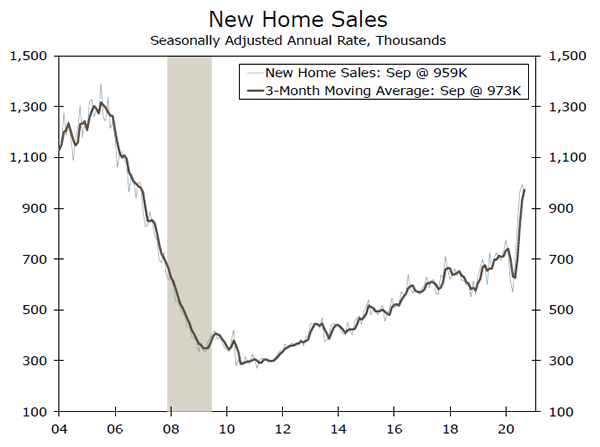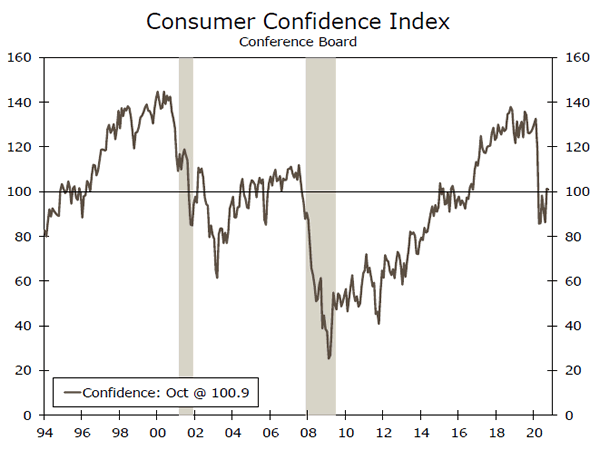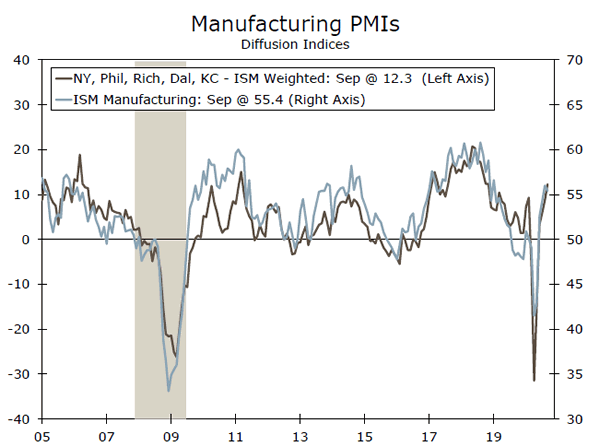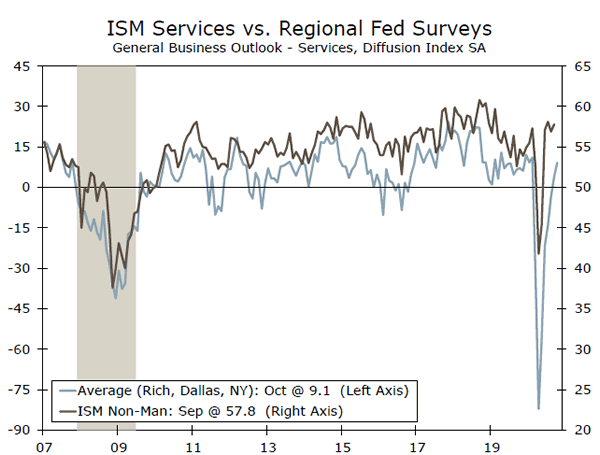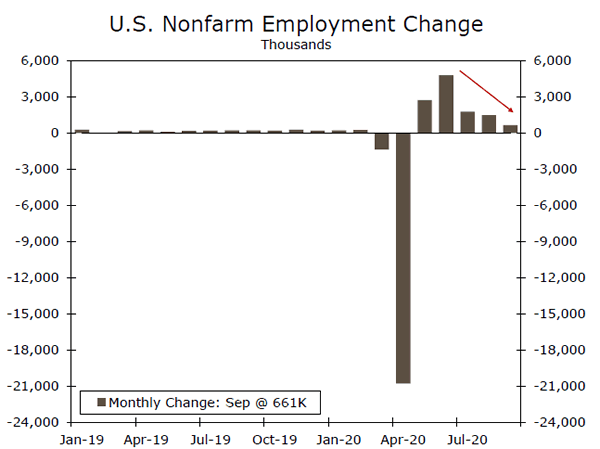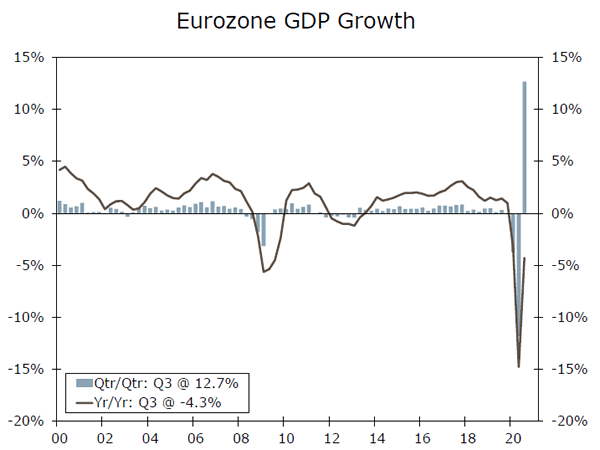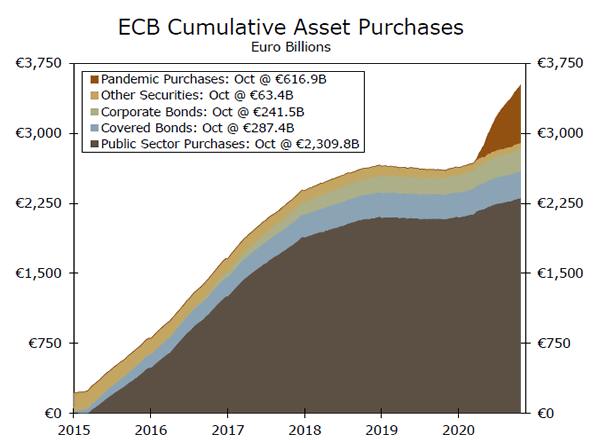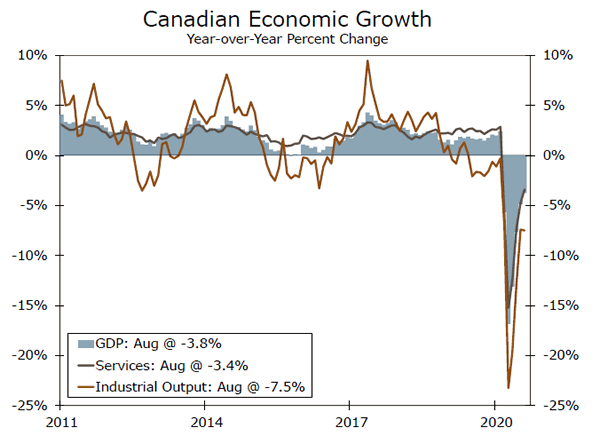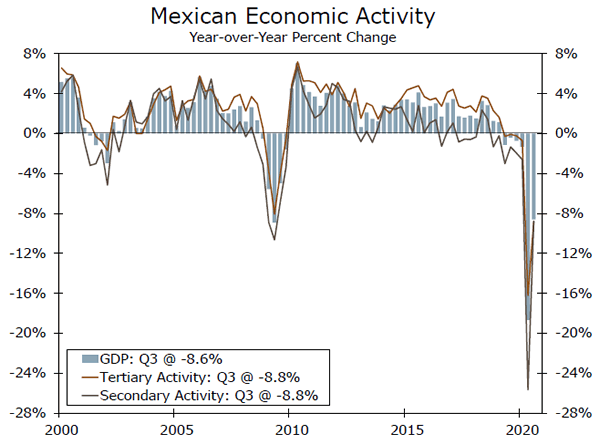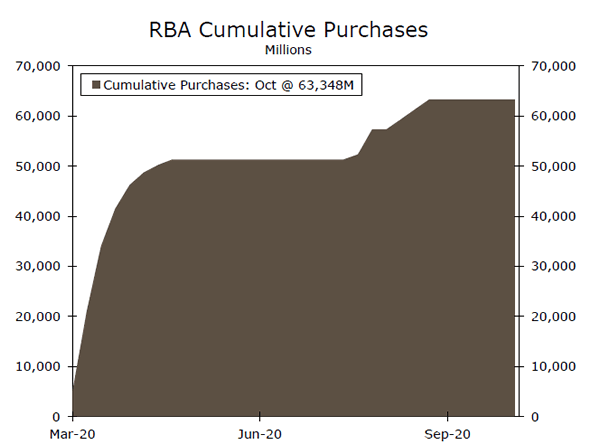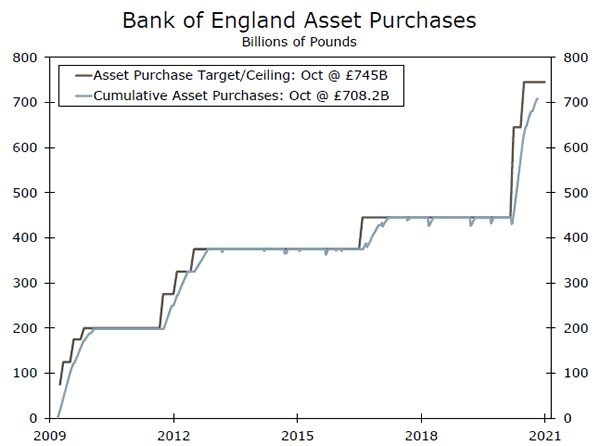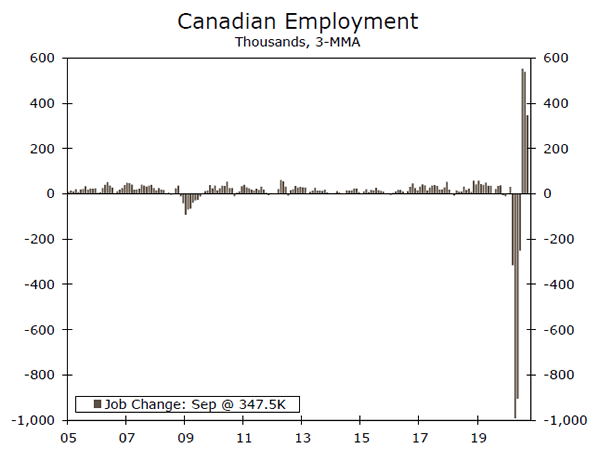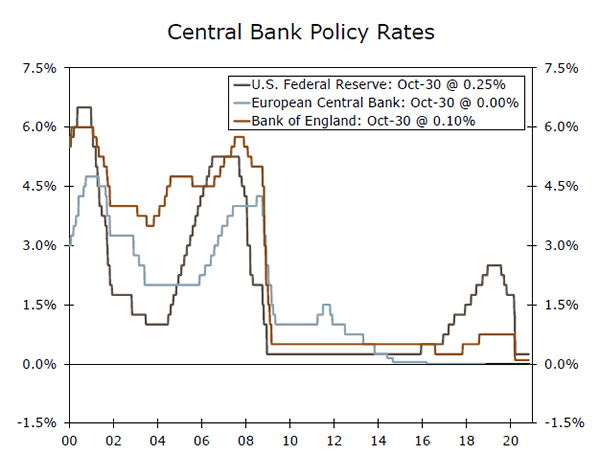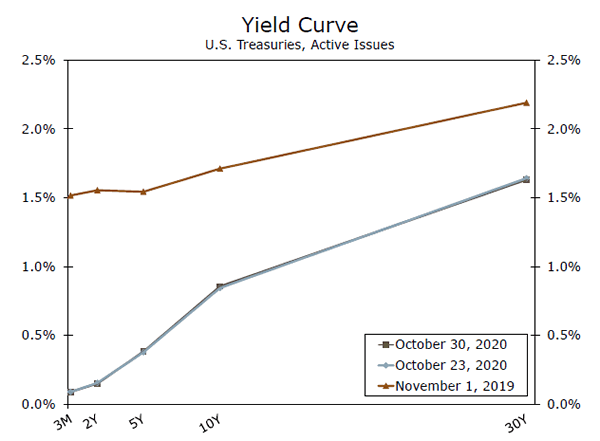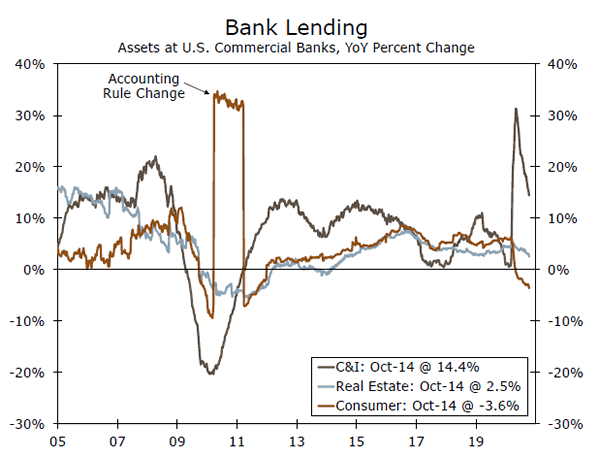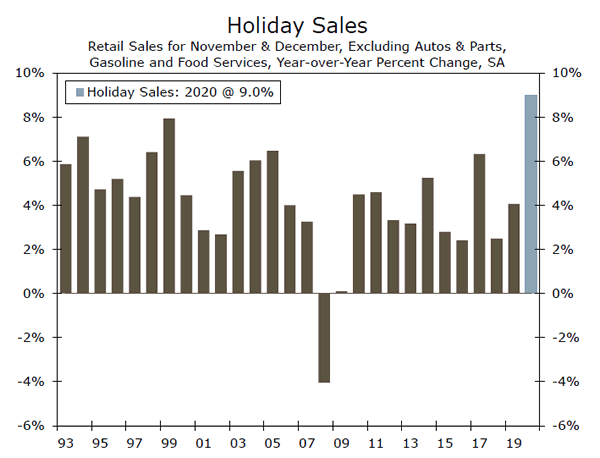U.S. Review
GDP Bounces Partway Back in Q3
- Real GDP jumped a record 33.1% during Q3, beating expectations. A 40.7% surge in consumer spending drove the gain. However, real GDP is still 3.5% below pre-pandemic levels.
- Initial jobless claims dropped to 751k for the week ending October 24, the lowest level since mid-March.
- Durable goods orders rose 1.9% in September, well above consensus estimates. In addition, new home sales fell 3.5% to a still-blistering 959K-unit pace.
- Consumer confidence edged down to 100.9 in October. Rising COVID cases may weigh on confidence in the months ahead.
GDP Bounces Partway Back in Q3
The big economic news of the week was the release of GDP for the third quarter. Real GDP climbed 33.1% on a quarterly annualized basis, by far the quickest increase on record. But the rapid upturn in Q3 comes off a 31.4% contraction in the previous quarter, which was also a record-setting performance but in the opposite direction. Because growth in Q3 started from a much lower base, real GDP is still roughly 3.5% below the peak level hit late last year before the pandemic hit.
Observers may also be wondering if the economy really expanded by one-third during Q3. The answer is no. Quarterly GDP growth rates are reported as “annualized” in order to estimate how fast the economy would grow (or shrink) if the same performance was repeated for four consecutive quarters. Not-annualized, and on a straight quarter-to-quarter basis, real GDP declined -9.0% in Q2 and then rose 7.4% in Q3. In “normal” times, when the economy tends to fluctuate by much smaller magnitudes each quarter, annualized growth rates can be informative. Understandably, this can also create some confusion when there are dramatic swings in growth such as we have seen over the past year.
That being said, the economy bounced back at a slightly faster rate than expected. Driving the turnaround was a 40.7% (annualized) surge in consumer spending. Spending was aided by a jump in incomes provided by stimulus checks and expanded unemployment benefits earlier this summer. Consumers shifting spending away from close-contact services (such as mass-transit) towards durable goods (such as on cars) also explains the upturn.
Business spending on equipment skyrocketed 70.1% during the quarter. The rebound in consumer durable goods spending has helped propel capex spending higher. Earlier in the week, durable goods orders were reported to have grown 1.9% (not annualized) in September, above consensus estimates. Core capital goods shipments, however, rose less than anticipated. This suggests that there is less momentum behind capex spending heading into Q4. Spending on nonresidential structures was one area that did not improve, falling -14.6% during Q3. Low energy prices continue to weigh heavily on oil and gas drilling activity, and rising vacancy rates are a huge obstacle for new commercial construction.
Residential investment leaped 59.3% (annualized) in Q3. Record low mortgage rates and shifting preferences for more livable space have spurred a swift recovery in both single family construction and home sales. Such rapid growth will be difficult to sustain, however, and we expect some moderation in Q4. The first signs of cooling in the housing market were evident in both the new and pending home sales reports for September. New home sales dropped 3.5% (not annualized) and pending home sales declined 2.2% during the month.
Overall, the economy appears to be losing a bit of momentum. Jobless claims have improved recently but remain elevated, falling to 751k for the week ending October 24. Consumer confidence also slipped in October. On top of that, new COVID cases are back on the rise. We expect Q4 GDP growth to remain solidly in positive territory, but to slow sharply relative to the robust pace hit in Q3.
U.S. Outlook
ISM Manufacturing • Monday
Manufacturing activity this year has been supported by the shift in spending from services toward goods since the pandemic. In September, the ISM manufacturing index remained firmly in expansion territory, even as new orders came off a sky-high reading the previous month.
We expect another solid reading in October. Manufacturers’ inventories remain below pre-COVID levels even as consumer goods spending has recovered and capital goods spending has been on the upswing. Other manufacturing PMIs released earlier in the month suggest activity continued to expand at a pace similar to September. The preliminary October Markit PMI was up a tick from its September reading, while the regional Fed manufacturing indices together point to another mid-50 reading for the ISM in October.
Previous: 55.4 Wells Fargo: 55.8
Consensus: 55.6
ISM Services • Wednesday
Service-sector activity was strong in September, with the ISM index surprising to the upside at 57.8. Firms reported a solid rise in new orders and stepped up hiring as activity continued to normalize.
We look for another solid reading from the ISM services index for the month of October as consumers and businesses battled COVID-fatigue. The recent resurgence in COVID cases is likely to dampen service sector activity regardless of whether governments impose new restrictions, but that is likely to be more of a story for November. The preliminary October Markit services index reported a pickup in activity through the early part of the month, while an average of the Richmond, New York and Dallas Fed service sector surveys showed activity expanding at a faster pace in October.
Previous: 57.8 Wells Fargo: 57.5
Consensus: 57.5
Employment • Friday
Job growth has slowed since the early summer when restrictions on activity were initially lifted. Last month’s gain of 661K jobs was held down in part by less education hiring than usual as schooling moved online and some temporary Census jobs ended. Layoffs among temporary Census workers will be an even bigger drag to payrolls in October, with the Census Bureau showing 147K fewer employees on the books during the survey week compared to last month. But incoming data such as initial jobless claims and consumers’ views of the labor market also suggest that the underlying pace of improvement continues to moderate.
The unemployment rate will likely edge down only slightly to 7.7% from 7.9%, as last month’s half-point drop was fueled by a plunge in labor force participation. Meanwhile, we expect average hourly earnings t0 tick up 0.2% in September.
Previous: 661K Wells Fargo: 530K
Consensus: 600K
Global Review
Renewed Questions Surrounding Global Recovery
- Eurozone Q3 GDP jumped more than 12% quarter-over-quarter, although that bounce did not fully recover declines from earlier this year. More concerning going forward is the renewed spread of COVID and clear signs of softening in service sector activity. Thus while the European Central Bank held monetary policy steady this week, it gave a clear signal further easing should be expected in December.
- In Canada an encouraging economic rebound continues, in turn prompting the central bank to stay on hold. Mexico’s Q3 GDP jumped after a large Q2 fall, while South Korea’s Q3 GDP gain was led in large part by export growth.
ECB Signals December Monetary Policy Easing
The European Central Bank (ECB) announced its monetary policy decision this week, leaving its key policy tools untouched. In particular the Deposit rate was unchanged at -0.50%, while there were also no changes to the ECB’s asset purchase programs. However, the accompanying comments were very dovish in nature, sending a strong signal that further monetary easing is likely in December. At the post-meeting press conference ECB President Lagarde said policymakers agreed it was necessary to take action and that there is “little doubt” policymakers will agree on new stimulus in December. Those comments came on top of the prepared statement which indicated the near-term outlook has deteriorated and that risks were clearly tilted to the downside. As a result, we now expect the ECB to announce a further €500B increase in Pandemic Emergency Purchases to €1,8500B in December, and to extend that purchase program through until at least December 2021. The ECB announcement comes as Eurozone Q3 GDP rose by 12.7% (not annualized) quarter-over-quarter, although that did not fully recover the even larger decline seen in the first half of this year. Among the larger Eurozone countries, German Q3 GDP rose 8.2% while French Q3 GDP rose 18.2%, both rebounding more than expected.
Canadian Recovery Continues, Bank of Canada on Hold
The Bank of Canada (BOC) also announced its monetary policy decision this week and essentially left monetary policy unchanged, making only modest technical adjustments. The central bank kept its policy interest rate unchanged at 0.25%. With respect to its bond purchases the BoC shifted its purchases toward longer-term bonds, which are viewed as having a more direct influence on borrowing rates for households and businesses. At the same time, the central bank said it would gradually slow its purchases to around C$4 billion per week, from around C$5 billion per week currently. There was a dovish hint in the announcement in that the central bank does not expect economic slack to be absorbed until 2023, and that the policy interest rate would be held at the effective lower bound until that time. Finally, the BoC’s forecast was less pessimistic than previous projections, with 2020 GDP seen falling 5.7% (compared to a prior forecast for a 7.8% decline). Indeed, the initial encouraging signs of an activity rebound continued in August. GDP rose 1.2% month-over-month, as service sector output and industrial output rose 1.5% and 0.1%, respectively.
Emerging Markets Emerging From the Downturn
A couple important emerging economies reported Q3 GDP data this week which looked impressive at first glance, but the details were a bit less impressive. Mexico’s Q3 GDP jumped 12.0% (not annualized) quarter-over-quarter, but that comes after a 17.1% fall in Q2. For Q3, tertiary sector activity (which includes services) rose 8.6%, while secondary sector activity (which includes manufacturing) rose 22.0%. Meanwhile, South Korea’s Q3 GDP rose 1.9% quarter-over-quarter, a bit more than expected. That said, consumer and investment spending were subdued, with the export sector the main driver of Q3 economic growth.
Global Outlook
RBA Policy Announcement • Tuesday
The Reserve Bank of Australia (RBA) announces its latest monetary policy announcement next week. Given dovish central bank comments and overall subdued data, Australia’s central bank is widely expected to ease monetary policy further at its November meeting.
Of note, September employment fell 29,500, at bit less than expected, but the details indicated a decline in full-time and part-time jobs. In addition, retail sales showed monthly declines in August and the preliminary sales figures for September, and recent confidence surveys have been mixed. In terms of central bank comments, Governor Lowe signaled he is willing to consider further easing, and that the RBA wants to see more than just “progress to full employment.” We expect the RBA to cut the Cash Rate and three-year government bond yield target 15 bps to 0.10%, and also expect the RBA to announce a further A$75B in bond purchases.
Previous: 0.25% Wells Fargo: 0.10%
Consensus: 0.10% (Cash Rate and 3-Year Yield Target)
BoE Policy Announcement • Thursday
The U.K. economy was hard hit by COVID and associated lockdowns in early 2020, with Q2 GDP slumping 19.8% quarter-over-quarter (not annualized). Activity has subsequently recovered, although the pace of the U.K. rebound has lagged that of most other advanced economies. Meanwhile uncertainties persist, with a post-Brexit trade deal still to be agreed and a recent and renewed uptick in the spread of COVID. The latter raises the risk of the further re-imposition of lockdown measures, which could also restrain the pace of recovery.
It is against this backdrop that we and the consensus expect the Bank of England to ease monetary policy further at next week’s meeting. We expect the central bank’s policy interest rate to remain unchanged at 0.10%. However, we do see a further £100B increase in the asset purchase target, to £845B from the current target of £745B. The central bank’s Inflation Report will also be published, offering the central bank’s latest GDP and CPI outlook.
Previous: £745B Wells Fargo: £845B
Consensus: £845B (Asset Purchase Target)
Canadian Employment • Friday
The Canadian economy has experienced an encouraging initial rebound from the COVID-induced decline in early 2020, an encouraging trend that could continue with the release of October labor market data. We expect an October employment increase of 150,000 which would be another solid gain, albeit not as large as the rise of 378,200 reported for September. Within the details, there is a reasonable chance that both full-time and part-time jobs will register increases in October. Should our forecast prove accurate, Canada’s labor market will have recovered around 80% of the jobs lost during the early stages of the pandemic.
The expected rise in October jobs should also see the unemployment rate fall further, to 8.6%. Next week’s data also includes the most up-to-date insight into the state of Canadian manufacturing in the form of the October manufacturing PMI, which fell sharply to 54.3 in September, but remained above the breakeven 50 level.
Previous: 378,200 Wells Fargo: 150,000
Point of View
Interest Rate Watch
Low Visibility Means Fed Is on Hold
When the Federal Open Markets Committee (FOMC) meets this coming Thursday there will be many things it is eager to see, but few of which will be in clear focus at that point.
The paramount concern is the state of the economy. While Q3 GDP showed a sharp rebound in the summer months, moderating activity since then suggests the economy is now expanding at a significantly slower pace.
The meeting will take place while votes from Tuesday’s election are still being counted. With mail-in votes expected to play a larger-than-usual role amid the pandemic, the outcome of the election could still hang in the balance from the top of the ticket to down-ballot races. Various Fed speakers in recent weeks have stressed the economic need for additional fiscal stimulus, and the outcome of the election has the potential to influence the complexion and timing of future stimulus.
With the adoption of a flexible average inflation targeting regime still a relatively fresh development, we are not bracing for any major shift in policy or forward guidance at the November FOMC meeting.
In our recently published Flashlight for the FOMC Blackout Period, we discuss how even in the absence of major fiscal policy developments, the Federal Reserve has a few potential remedies at its disposal for a still-ailing economy and low inflation.
These include ramping up its asset purchase program or further easing the terms of its emergency lending programs, such as the Main Street Lending Program (MSLP) and the Municipal Liquidity Facility (MLF).
Although the FOMC is likely to be in a holding pattern at the November meeting, it could announce accommodative steps in upcoming meetings if economic conditions do not improve. The September SEP showed FOMC members generally expected a somewhat stronger recovery in GDP and the labor market compared to June.
However, the bulk of the committee did not expect inflation to reach its longer-run goal of 2.0% until 2023. This meeting will likely be about setting the table for future meetings at which the FOMC can announce more meaningful policy changes.
Credit Market Insights
December Debt Looms Over Renters
Uncertainty about households’ ability to pay rent has grown following a series of failed stimulus negotiations. Investigating these concerns, the Philadelphia Federal Reserve released its Household Rental Debt During COVID-19 study, which estimated the number of households with rental debt to gauge how many households could be at risk of eviction once the national eviction moratorium expires in about two months.
The results showed fiscal stimulus’ dramatic effect—receiving unemployment insurance was the strongest determinant of accumulation of rental debt. Assuming that 90% of renter households received Economic Impact Payments and half of workers who lost their job since March benefitted from enhanced unemployment benefits under the CARES Act, estimates showed that by the end of December around 1.34M renter households will owe about $5,400 each in rental debt. That said, outcomes varied by assumption. For example, if all unemployed workers received CARES UI and stimulus, only 125K households are estimated to have rental debt, with each owing $2,800 in debt. On the other hand, if households did not receive any fiscal support, a whopping 3.4M households are estimated to hold rental debt by the end of December, each owing $5,400. Given uneven effects in the labor market due to the virus, minority and female households are expected to have disproportionately higher debt.
As highlighted by our recent report on the rental market, households have managed to keep up with monthly rental payments so far. But going forward, how much fiscal aid is given and to how many of those suffering at the hands of the pandemic has important human and economic consequences.
Topic of the Week
Holiday Sales Outlook
The winter holidays will be here before we know it, and in what will undoubtedly be remembered as one of the most challenging and transformative years for most retailers, we are forecasting holiday sales to increase a record 9.0% in 2020 compared to last year (top chart).
This is not to say that things are fine for all retailers (they are not), nor is it to say that consumers are in excellent financial shape (they are not, particularly not toward the lower end of the income spectrum). But, a forced thrift that has curtailed spending on many services frees up income for spending on goods. Further, after the anxiety and stress of a year defined by COVID, natural disasters and a divisive election, we suspect holiday sales will also benefit from a yearning for comfort and normalcy, which many consumers may associate with having a few more gifts under the tree.
Traditions of the shopping season will be largely replaced this year with rolling special sales and “buy-online, pick-up in store” deals while online retailers pile on gains after last year’s first-time finish as top overall category of holiday sales. In fact, since Amazon’s “Prime Day” was in October, many of its competitors began offering special offers during the month. Some holiday shopping has already likely been pulled forward, so we would not be surprised to see the pace of sales taper off in the traditional holiday spending months of November and December.
Even if that is the case, our measure of holiday sales sits comfortably at an all-time high as of September after disruption from the virus earlier this year (bottom chart). The 2020 holiday sales season is thus on track to be a blowout. But, keep this in perspective: this boon in goods spending is coming at the expense of spending on services, which remains depressed. In short, we do not look for overall consumer spending to return to its pre-crisis peak until mid-2021.
Please see our full Holiday Sales Outlook for a deeper dive into particular categories of holiday spending, how we came to our forecast and details regarding the seasonal adjustment process that may have an outsized influence over the data produced in the final sales figures this year.




